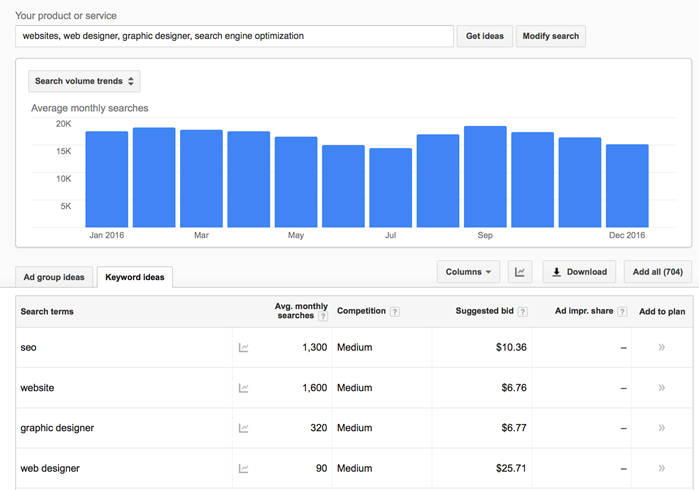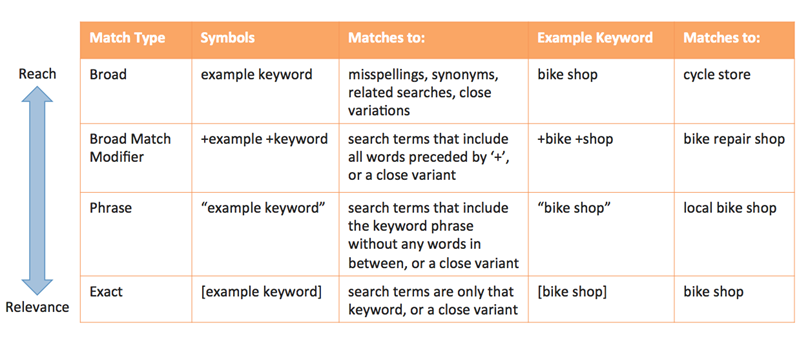Ask many small business owners about online ads, and you might hear something like this:
“I tried AdWords, but it just didn’t work for me.”
Or worse still, perhaps they bought ads from Yelp and received little to no return on ad spend (ROAS). Then they threw up their hands despairingly and concluded that Internet ads are no good.
(Protip: Never buy Yelp ads.)
Here’s the thing: most people don’t use AdWords correctly because, admittedly, it’s not 100% intuitive without some understanding of Internet marketing and search engine traffic. Even when you do have a working knowledge of those things, it’s not always simple to maximize AdWords to its full potential.
But on the other hand, if you do use AdWords correctly, it can be a terrific channel. Here’s how to do it right. If Charlton Heston were here today, these are the commandments he would have for you.
1. Thou Shalt Research Keywords
I sure hope that this one goes without saying. There’s a reason it’s commandment number one. If you are running a Google AdWords campaign, you had better be doing some solid keyword research. If you aren’t planning your keywords well, your AdWords budget might be spilling away into the void with little return on your investment. This article isn’t a detailed guide to keyword research, but there are plenty of resources available. If you invest some time into learning how to do good keyword research, it will be worthwhile.
2. Thou Shalt Track Conversions
You need to know how customers are responding to your ads. It’s crucial to know what kinds of conversions you are getting, and where they are coming from. If you don’t track conversions, you won’t be able to calculate your Return On Ad Spend (ROAS). Ads are only worthwhile if they bring in more money for your business than the cost of the ads themselves (duh!), and you want to know whether your AdWords campaign is profitable. After you get a click, do they sign up for your email list afterwards? Do they call your business? Do they make a purchase on your website? Tracking conversions is the only way for you to know whether your ads are paying for themselves, as they should be.
Thankfully, AdWords comes equipped with a free tool to do this – it’s called (conveniently enough) “conversion tracking.” Here’s how to use it with another amazing tool: Google Tag Manager.
[rankya_youtube_schema id=”7aGNwiXal_M” videotitle=”AdWords Local Business Conversion Tracking Using Google Tag Manager 2017″ desc=”How to set up AdWords conversions for a local business website once Google Tag Manager is installed. ” durationmin=”11″ durationsec=”14″ uplod=”2017-03-22″ rating=”TRUE”]
3. Thou Shalt Use Extensions
Extensions are a nifty feature that can make extra info show up below your ad and allow you take up more of that valuable result page real estate. This could include:
- Calling extensions that make your phone number readily available
- Reviews and rankings
- Callout text for features or benefits
- Relevant location info
Extensions are pretty versatile! While your extensions won’t be displayed all the time for every user (Google’s almighty algorithms get to decide when they show up), you should still set them up and make use of them. There’s no cost for adding extensions; you will still be charged the same for each click, regardless of whether you utilize extensions. So do it!
4. Thou Shalt Use Keyword Modifiers
There are different options for matching keywords to the search terms of your potential customers. The broadest matching options will cause your keyword to match with synonyms and what Google’s algorithm deems to be related searches. This will expose your ads to the widest amount of traffic, but your ads might not be relevant to many of those web searchers. With the narrowest settings, your keyword will only be matched with exactly the same words.
Using the Exact Match options can be beneficial because you then have the ability to serve up ad text which matches exactly what someone Googled for. This technique is recommended in Perry Marshall’s canonical AdWords guide, which I highly recommend.
You can control these matching options by using keyword modifiers such as brackets and quotation marks. Honestly, the best way to explain this is with a visual, so check out the table below.
If that chart still leaves you scratching your head, check out this explanation from Google.
5. Thou Shalt Add Negative Keywords
Negative keywords exclude your ads from being displayed to users whose searches include those terms. Why would you want to do that? The reason is that some users are less likely to become paying customers or clients. If you offer top quality pest control, then a person searching for “cheap pest control” is probably less likely to actually convert and pay money to your business than someone searching for “best pest control.” Not all clicks are equal; some are less valuable to you. You want your ads to reach high-value potential customers.
Here’s a second example: someone searching “best digital SLR cameras” might be in the research phase of their buying journey, but someone searching for “Canon EOS 5D Mark IV” is likely closer to making a purchase. Use keyword planning and the search terms report to narrow in on negative keywords and maximize the effectiveness of your traffic.
6. Thou Shalt Not Use AdWords Express
I’m serious. Just don’t do it. There is one, and only one, benefit to AdWords Express: simplified setup. On the other hand, consider the negatives of AdWords Express: restricting limitations on managing your ads, little to no control over your keywords, lack of reports and analytics, and no easy migration to the full AdWords. I promise you that it’s worth the extra initial effort of setting up AdWords.
7. Thou Shalt Not Direct to Thine Homepage
The user typed particular search terms into Google, and they’re looking for something specific. They saw your ad and decided that it just might be that specific thing that they’re looking for. So they gave you a click. Now what? They see that you opened in 1989 and offer all kinds of services that they weren’t searching for.
You need to give them what they came looking for! Don’t dump them on the general front page of your site. You don’t want to lose customers as soon as they click through to your site. Otherwise, you just wasted money on a click that could have been promising.
8. Thou Shalt Create Custom Landing Pages
Okay, so #7 and #8 are really the same (or at least two sides of the same coin). Instead of leaving customers stranded on your homepage, your ads should direct them straight to customized landing pages. You need to show them content that matches what they are looking for. If you’ve done solid keyword research and you know what kind of traffic is driving users to your site, that should be no problem.
Web searchers should click on your ad and then immediately find themselves thinking, “Aha! This is exactly what I was looking for.” Present your customers with a landing page tailored to their search, and then offer a very clear call to action. This is a crucial step in building an effective conversion funnel.
9. Thou Shalt Not Envy Thy #1 Neighbor
The idea here is that, unlike in SEO, you don’t always have to be the #1 ad. Note that as many as four Google ads can appear at the top of a results page and three more can appear at the bottom. The very top ad doesn’t always earn more clicks than the ones below it. Even if it does, it may cost more per click, and the goal isn’t to win the most clicks — it’s to earn customers at a profitable rate. Always keep this in mind:
(# of clicks) x (cost of clicks) < (the profit you made from the campaign)
If that expression is true, then congratulations! You just found a money-making machine. You put money in, and more came out.
10. Thou Shalt Experiment & Optimize
In some ways, using AdWords is a science, but it’s also an art. You should approach it in both ways. There are proven methods that work well, and there are also mistakes to be made. It is possible to use AdWords incorrectly, so use your good sense and follow the commandments outlined here.
Thankfully, there are troves of resources available to help guide you. We like Perry Marshall’s guide and Isaac Rudansky’s Udemy course.
But above any advice or documentation, trust your data. Experiment and find what’s working for you, and what’s not. Rely on the search terms report and your conversion rate analytics. Your campaigns likely won’t be profitable immediately, but give them a reasonable time frame to improve as you optimize them (at least 3-6 months), cutting out unwanted clicks and improving your ad copy along the way.
Over time, you will either be able to say definitively that AdWords is not a profitable strategy for you, or you’ll be able to drive valuable traffic into your marketing funnel and convert it for more than you spent on ads. The latter is preferable, but both outcomes are valuable to your business.




